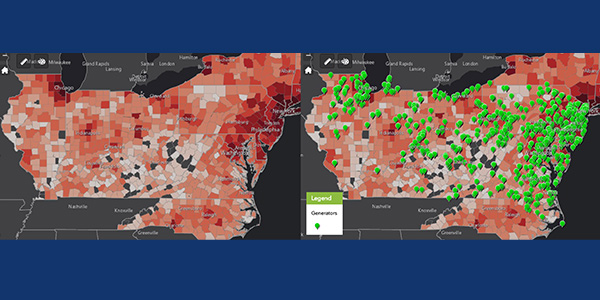PJM could support the loss of up to 40% of installed generation capacity on a summer day and up to 60% on a spring day in a worst-case scenario situation in which units were knocked offline from a COVID-19 outbreak among plant workers, the RTO said last week.
Ray Lee, senior engineer in generation, and Jason Sexauer, senior engineer for outage analysis technologies, presented the generator availability analysis to stakeholders during PJM’s weekly coronavirus call Friday.
Lee said the analysis was intended to determine the maximum generation loss PJM could handle without curtailing power to the hardest hit areas. The analysis began by considering the impact of an outbreak at one plant spreading and disabling a generating company’s entire fleet, he said.
Sexauer said the 40% and 60% outage levels in the scenario are about twice as many outages as typically occur during summer and spring. “These scenarios are worst case, far and above what we normally screen for from an operational perspective,” Lee said.
PJM has not seen any generator outages from the pandemic thus far, they said.
Analysts used overlay maps to compare the highest levels of COVID-19 infection within the PJM footprint with generator locations, Lee said, focusing specifically on New Jersey, the Interstate 95 corridor from New Jersey to D.C., and Chicago and its suburbs.
Lee said coal-fired and combined cycle plants were judged most likely to be impacted by an outbreak because they require higher numbers of on-site personnel to operate.
The final step in the planning process was to define the appropriate time frames for outbreaks at the sites, Lee said.
Because of uncertainty over how long the pandemic will last, PJM decided to perform the studies for the spring and summer peak loads. The findings “could then be used to potentially consider proactive actions, such as limiting future outages if we’re seeing a trend towards these worst-case scenarios,” he said.
Sexauer said four steps were used in the process for calculating the outages, including: selecting the hypothetical generation units that would go offline; building an “all-in case” for May 4 and July 7 using normal load on those dates; creating an “all-out case” where all scheduled transmission and hypothetical generation outages from COVID-19 were applied; and running a DC/AC contingency analysis on the hypothetical cases to look for thermal overloads and “non-converged contingencies,” in which no solution is found.
He said that while running the analysis, PJM found that thermal issues with the grid were more prevalent in the spring and voltage collapse issues were more prevalent in the summer. About 5,200 cases were analyzed, requiring two days of computer runs.



